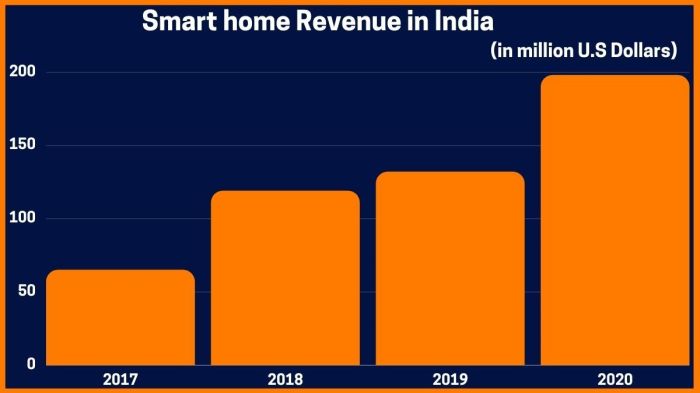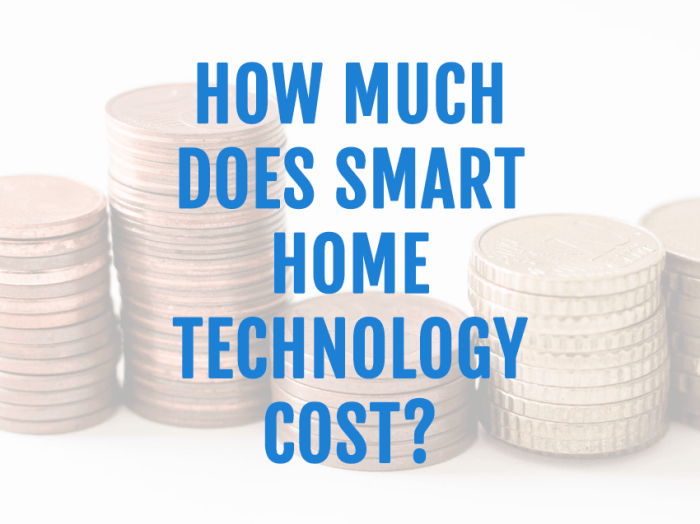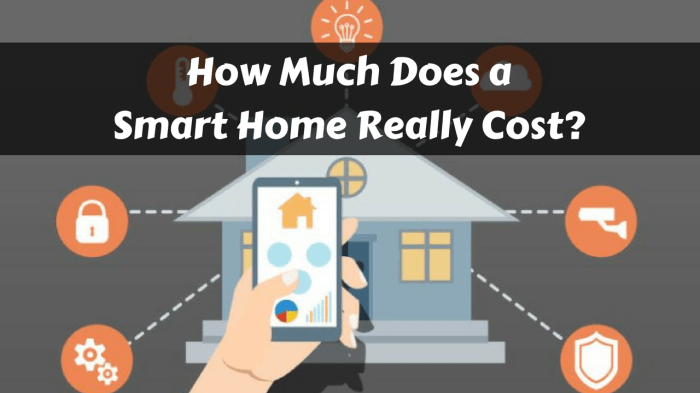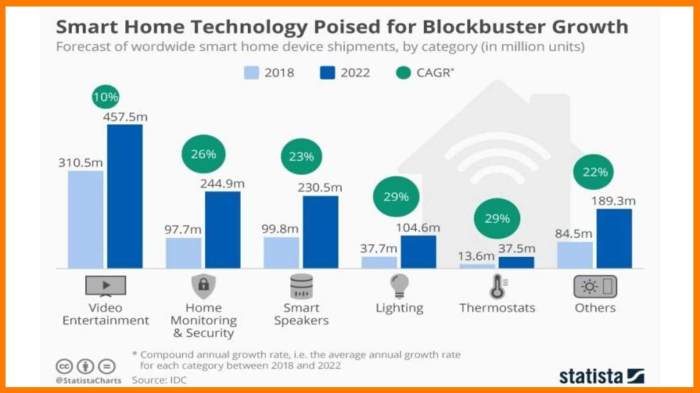In an era where technology permeates every aspect of our lives, the concept of a smart home has captured the imagination of homeowners seeking convenience, efficiency, and enhanced living experiences. While the allure of smart home systems is undeniable, the question of cost often lingers in the minds of potential adopters.
This comprehensive guide delves into the intricacies of smart home costs in India, providing valuable insights into factors influencing the overall expense and offering strategies for budget-conscious individuals.
From exploring device categories and their functionalities to understanding installation and maintenance costs, this exploration unveils the secrets behind smart home pricing. Additionally, it examines the significance of integration and compatibility, delving into the world of smart home platforms and their impact on device interoperability.
As the smart home industry continues to evolve, this guide also sheds light on emerging trends and the role of government initiatives in shaping the market landscape.
Smart Home Cost Overview in India

The rising popularity of smart home technology has revolutionized the way people live and interact with their homes. In India, setting up a smart home system can elevate comfort, convenience, and security. However, the total cost associated with building a smart home can vary depending on several factors.
Factors Influencing Smart Home Cost
Several elements impact the overall cost of a smart home system in India:
Number of Devices
The number of smart devices you plan to install significantly affects the total cost. The more devices you integrate, the higher the upfront investment.
Type of Devices
The type of smart devices you choose can also impact the cost. Some devices, such as smart lights and thermostats, are generally more affordable than high-end gadgets like smart refrigerators or home security systems.
Installation Charges
Professional installation can add to the overall cost, especially for complex systems. However, DIY (Do-It-Yourself) installation can save money if you have the technical expertise.
Maintenance and Subscription Fees
Some smart home devices may require ongoing maintenance or subscription fees for updates and additional features. These recurring costs should be considered when budgeting for a smart home system.
Typical Costs Associated with Smart Home Components
The cost of smart home components can vary widely depending on the brand, features, and complexity. Here’s a general overview of typical costs:
Smart Speakers
₹2,000 to ₹10,000
Smart Lighting
₹1,000 to ₹5,000 per bulb
Smart Thermostats
₹5,000 to ₹15,000
Smart Security Cameras
₹2,000 to ₹10,000 per camera
Smart Door Locks
₹5,000 to ₹15,000
Smart Home Hubs
₹5,000 to ₹15,000
Installation Charges
₹500 to ₹2,000 per device
Maintenance and Subscription Fees
Varies depending on the device and service provider
Budget Considerations for Smart Home Systems

Implementing a smart home system doesn’t have to break the bank. With careful planning and strategic purchasing, you can create a smart home that fits your budget and lifestyle. This section delves into budget considerations, cost-saving strategies, and recommendations for selecting affordable smart home devices.
To help you navigate the various options available, we’ve compiled a comparison table outlining budget ranges, types of devices included, and features offered in smart home systems:
| Budget Range | Types of Devices Included | Features Offered |
|---|---|---|
| Under ₹10,000 | Smart plugs, smart bulbs, and basic security devices | Remote control, scheduling, and energy monitoring |
₹10,000
|
Smart thermostats, smart door locks, and smart speakers | Advanced scheduling, geofencing, and voice control |
₹25,000
|
Smart home hubs, smart cameras, and smart appliances | Whole-home automation, security monitoring, and energy management |
| ₹50,000 and above | Custom-designed smart home systems | Extensive automation, personalized scenes, and integration with luxury appliances |
Cost-Saving Strategies for a Tight Budget
If you’re working with a limited budget, consider the following cost-saving strategies:
- Start with a few essential devices: Prioritize devices that offer the most value and functionality for your needs. This could include smart plugs, smart bulbs, and a smart speaker.
- Gradually expand your system: As your budget allows, add more devices to your smart home system. This approach lets you spread the cost over time and ensures you’re only purchasing devices that you truly need.
- Look for sales and discounts: Many retailers offer discounts on smart home devices during special sales events or holidays. Keep an eye out for these opportunities to save money.
- Consider refurbished or used devices: Refurbished or used smart home devices can be a cost-effective option, especially for budget-conscious consumers. Just make sure to do your research and purchase from reputable sellers.
Recommendations for Selecting Affordable Smart Home Devices
When selecting affordable smart home devices, consider the following recommendations:
- Choose devices that are compatible with your existing smart home platform: This ensures that all your devices can communicate and work together seamlessly.
- Look for devices that offer a good balance of features and price: Don’t overpay for features you don’t need. Instead, focus on devices that offer the essential features you’re looking for at a reasonable price.
- Read reviews and compare prices: Before purchasing a smart home device, read reviews from other users and compare prices from different retailers. This will help you make an informed decision and get the best value for your money.
Exploring Different Smart Home Device Categories
Smart home devices offer a range of functionalities that enhance convenience, energy efficiency, and home security. These devices fall into several categories, each serving a specific purpose.
Smart Lighting
Smart lighting systems allow users to control lights remotely, set schedules, and adjust brightness and color. They can be integrated with other smart home devices to create personalized lighting scenes and automate tasks.
Smart Thermostats
Smart thermostats regulate home temperature efficiently. They can be programmed to adjust temperature based on daily routines, weather conditions, and user preferences. This optimization leads to energy savings and improved comfort.
Smart Security Systems
Smart security systems provide enhanced home protection. They typically include motion sensors, door/window sensors, and security cameras. These systems can be monitored remotely via smartphones, allowing homeowners to keep an eye on their property from anywhere.
Smart Speakers
Smart speakers are voice-controlled devices that integrate with various smart home devices. They enable users to control smart devices, play music, access information, and manage tasks using voice commands. Popular Smart Home Brands and Price Ranges
-
-*Smart Lighting
Philips Hue (₹2,000
- ₹10,000), Wipro Smart (₹1,000
- ₹5,000), Syska Smart (₹1,500
- ₹6,000)
- ₹15,000), Ecobee Thermostat (₹15,000
- ₹20,000), Honeywell Thermostat (₹5,000
- ₹10,000)
- ₹30,000), ADT Pulse (₹30,000
- ₹40,000), Vivint Smart Home (₹40,000
- ₹50,000)
- ₹10,000), Google Home (₹4,000
- ₹10,000), Apple HomePod (₹20,000
- ₹30,000)
-*Smart Thermostats
Nest Thermostat (₹10,000
-*Smart Security Systems
SimpliSafe (₹20,000
-*Smart Speakers
Amazon Echo (₹4,000
Installation and Maintenance Costs of Smart Home Systems
Professional installation is often essential for smart home devices, especially those involving electrical work or complex setups. This ensures proper functioning, safety, and adherence to building codes. Installation costs vary widely, ranging from minimal fees for simple devices to substantial charges for elaborate systems.
Installation Costs
Lighting
Installation costs for smart lighting systems typically range from ₹500 to ₹2,000 per fixture. Professional installation may be necessary for complex setups involving multiple zones or dimmers.
Thermostats
Basic smart thermostats can be self-installed, but professional installation is recommended for complex systems or those requiring electrical work. Installation costs can range from ₹1,000 to ₹5,000.
Security Systems
Professional installation is strongly advised for security systems, as improper setup can compromise security. Installation costs vary depending on the system’s complexity and the number of sensors and cameras. Expect to pay between ₹10,000 and ₹50,000 for installation.
Maintenance and Longevity
Regular updates and proper usage are crucial for maintaining smart home devices. Updates ensure compatibility with the latest software and security patches, while proper usage prevents damage and extends device lifespan.
- Regularly check for software updates and install them promptly.
- Use devices according to manufacturer guidelines to avoid damage or malfunctions.
- Clean and maintain devices as per the manufacturer’s instructions to ensure optimal performance.
- Monitor energy consumption and adjust device settings to optimize efficiency and save energy.
Smart Home Integration and Compatibility

Integrating and ensuring compatibility among smart home devices is crucial for a cohesive and seamless smart home experience. Smart home integration refers to the ability of various smart devices to communicate and work together, enabling centralized control and seamless interoperability.
Compatibility between smart home devices and platforms is essential for a cohesive and seamless smart home experience. Compatibility ensures that devices can communicate with each other and be controlled from a single platform, allowing for centralized control and seamless interoperability.
Importance of Compatibility Standards
The compatibility of smart home devices and platforms is largely determined by the use of common standards. These standards define the communication protocols, data formats, and security measures that enable devices from different manufacturers to work together seamlessly.
Some of the most widely used smart home standards include:
- Zigbee: A low-power wireless standard specifically designed for smart home devices, Zigbee is known for its reliability, energy efficiency, and mesh networking capabilities.
- Z-Wave: Another low-power wireless standard optimized for smart home applications, Z-Wave is known for its long range, stability, and security features.
- Wi-Fi: The most common wireless networking technology, Wi-Fi is supported by a wide range of smart home devices, providing high bandwidth and flexibility.
Popular Smart Home Platforms and Their Compatibility
Several popular smart home platforms are available, each with its own strengths and supported devices. Some of the most notable platforms include:
- Google Home: Google Home is a voice-activated smart home platform that allows users to control compatible devices, access information, and manage tasks using voice commands.
- Amazon Alexa: Amazon Alexa is a voice-activated smart home platform that offers similar capabilities to Google Home, including voice control of compatible devices, information access, and task management.
- Apple HomeKit: Apple HomeKit is a smart home platform that allows users to control compatible devices using the Apple Home app or Siri voice commands.
These platforms vary in their compatibility with different smart home devices. For example, Google Home and Amazon Alexa support a wide range of devices from various manufacturers, while Apple HomeKit has a more limited selection of compatible devices.
Smart Home Trends and Future Outlook

The smart home industry in India is poised for significant growth, driven by several emerging trends that are reshaping the market. These trends include the rise of voice control, artificial intelligence (AI), and the Internet of Things (IoT).
Voice Control and AI
Voice control has become a popular way to interact with smart home devices, thanks to the increasing popularity of voice assistants like Amazon Alexa, Google Assistant, and Apple Siri. This trend is expected to continue, with more smart home devices incorporating voice control capabilities.
AI is also playing a growing role in smart homes, with devices becoming more intelligent and able to learn and adapt to user preferences. This is leading to more personalized and intuitive smart home experiences.
IoT and Connectivity
The IoT is another key trend driving the growth of the smart home market in India. IoT devices are physical objects that are embedded with sensors, software, and other technologies that allow them to connect and exchange data with other devices and systems over the internet.
This connectivity enables smart home devices to communicate with each other and with the cloud, allowing users to control and monitor their homes from anywhere.
Government Initiatives and Regulations
Government initiatives and regulations can also play a role in shaping the smart home market in India. For example, the government’s “Smart Cities Mission” aims to develop 100 smart cities across the country. This initiative is expected to boost the demand for smart home technologies, as smart cities require a high level of connectivity and automation.
Potential Impact on Cost and Accessibility
These emerging trends are expected to have a positive impact on the cost and accessibility of smart home systems in India. Voice control and AI are making smart home devices more user-friendly and accessible to a wider range of consumers.
The IoT is also helping to drive down the cost of smart home devices, as more devices are being produced and sold. Additionally, government initiatives and regulations are creating a more favorable environment for the adoption of smart home technologies.
Last Point

The journey into smart home costs in India reveals a dynamic landscape influenced by a multitude of factors. From the initial investment in devices and installation to ongoing maintenance and integration considerations, the financial implications can vary significantly. However, with careful planning, informed decision-making, and strategic budgeting, homeowners can navigate the smart home terrain and reap the benefits of a connected, intelligent living space.
As technology continues to advance and government initiatives foster innovation, the future of smart homes in India holds immense promise, offering the potential for even more accessible and cost-effective solutions.
Helpful Answers
Q1. What factors primarily influence the overall cost of a smart home system in India?
A1. The total cost of a smart home system is influenced by several key factors, including the number and type of devices chosen, the complexity of installation, and ongoing maintenance expenses.
Q2. Can I save money by installing a smart home system myself?
A2. While DIY installation can potentially save on labor costs, it’s crucial to consider the complexity of the system and your technical expertise. Professional installation is recommended for certain devices, especially those involving electrical work or intricate setups.
Q3. What are some cost-effective smart home devices that offer good value for money?
A3. Several affordable smart home devices provide excellent functionality at a reasonable price. These include smart plugs, smart bulbs, and budget-friendly smart speakers. Additionally, consider purchasing devices during sales or promotions to maximize savings.
Q4. How can I ensure the longevity and optimal performance of my smart home devices?
A4. Regular updates, proper usage, and preventive maintenance are key to extending the lifespan of smart home devices. Additionally, surge protectors can safeguard devices from power fluctuations, while following manufacturer guidelines for usage and maintenance can help prevent premature failures.
Q5. What are some popular smart home platforms, and how do they impact device compatibility?
A5. Google Home, Amazon Alexa, and Apple HomeKit are prominent smart home platforms. Choosing a platform that supports the devices you intend to use is crucial for seamless integration and interoperability. Additionally, consider platforms with a wide range of compatible devices to future-proof your smart home system.